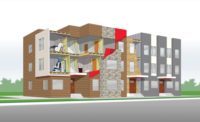What is the difference between fire resistance ratings and flame-spread ratings? Can they be used interchangeably?
Fire resistance ratings and flame-spread ratings cannot be used interchangeably. A fire resistance rating is defined as the time, in hours or fractions thereof, that systems will resist fire penetration when tested in accordance with ASTM E119 (Standard Test Methods for Fire Tests of Building Construction and Materials), which is sometimes called the “furnace test.” Fire resistance ratings determined by this test method measure the relative effectiveness of assemblies to act as fire barriers.
A flame-spread rating, on the other hand, is the assessment of the relative rate at which fire will propagate over the surface of a material. ASTM E84 (Standard Test Method for Surface-Burning Characteristics of Building Materials) is used to establish flame-spread ratings and measure smoke generation. In this test, inorganic, reinforced cement board is assigned an index of 0 and red oak an index of 100. From these benchmarks, relative values are established, with a higher number indicating a greater rate of flame propagation. The flame-spread rating of paper-faced board is approximately 15 and that of glass-faced panels is 0.
Think of being in a burning corridor with a fire resistance rating of one hour. It is decorated with a fabric wall covering material that has a very high flame-spread rating. If you can get out of the corridor, you’ll be protected by the fire resistance of the wall assembly; however, if the wall fabric is extremely flammable, all your efforts to escape may well be futile, as the flames may be exacerbated by the wall covering. Both fire resistance and flame-spread ratings are important fire protection concepts, but they do have distinctly different applications. Gypsum products offer both high fire resistance ratings and low flame-spread ratings — one of the reasons they are integral to fire-rated construction.






Report Abusive Comment